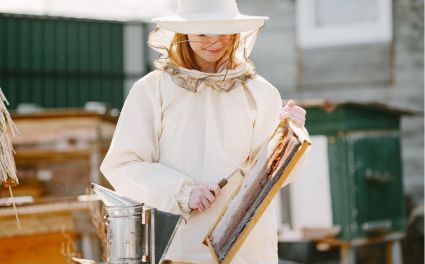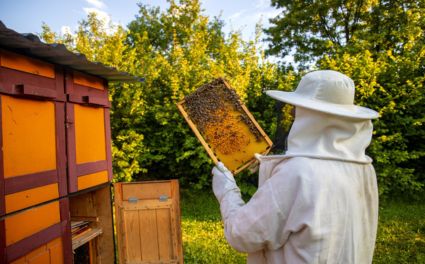Bees are fascinating creatures that play a vital role in our ecosystem. They diligently pollinate plants, produce delicious honey, and work together as a highly organized colony. But have you ever wondered how beekeepers handle these buzzing wonders without getting stung? One of their secret tools is the smoker. In this blog post, we will explore why beekeepers use smokers, how they work, and the benefits they provide. So sit back, grab your protective gear (just kidding!), and let's dive into the world of beekeeping!
Understanding Bee Behavior
To fully comprehend why beekeepers use smokers, it's essential to first understand the behavior of bees. Bees are highly organized insects that live in complex colonies with strict hierarchies and divisions of labor. You'll find worker bees (females), drones (males), and a queen within a hive. Worker bees have multiple tasks, such as collecting nectar, pollen, building honeycombs, and caring for larvae. They communicate through intricate "waggle dances" to convey information about food sources or potential new nesting locations.
However, despite their crucial role in pollination and honey production, bees can become agitated when disturbed or threatened. This is where the smoker comes into play - it helps calm the colony by mimicking natural events like forest fires. When a hive senses smoke, they instinctively believe there might be an imminent threat of fire destroying their precious home. In response to this perceived danger, the bees gorge themselves on honey from nearby combs. This engorgement induces a sense of satiety that makes them less likely to sting intruders during inspections or harvesting.
Understanding these intricacies of bee behavior and utilizing this knowledge effectively with smokers can significantly enhance beekeeper safety and overall hive management strategies.
Mechanism and Function of Smokers
Beekeeping is a delicate art that requires careful attention to the behavior and needs of these tiny pollinators. One tool that beekeepers rely on is the smoker, a device designed to produce smoke that can calm bees during hive inspections. But have you ever wondered how smokers actually work? The mechanism behind smokers is quite simple yet ingenious. They consist of a metal firebox or chamber where fuel, such as wood chips or burlap, can be ignited. The bellows attached to the firebox allow air to be pumped into the chamber, creating a continuous stream of smoke.
But what exactly does this smoke do? Well, it turns out that bees are highly sensitive creatures with a keen sense of smell. When they detect smoke around their hive, they interpret it as an indication of danger - approaching forest fires. In response to this perceived threat, the bees instinctively begin consuming honey in preparation for potentially fleeing their home.
This consumption triggers various physiological changes within the bees' bodies: their abdomens become engorged with honey while simultaneously reducing their aggression levels. By using the smoker and introducing smoke into the hive environment before inspection or manipulation, beekeepers can trick these small insects into thinking there's an imminent wildfire nearby.
By employing this technique strategically and skillfully during hive inspections or when working with swarms or aggressive colonies, beekeepers can reduce stress levels among themselves and their buzzing charges. In addition to calming bees down during manipulations and inspections, smokers also serve another important function – masking pheromones released by guard bees when defending against intruders. These pheromones act as alarm signals for other colony members but can be overpowered by smoke particles suspended in the air.
With reduced aggression from consumed honey and masked alarm signals due to heavy smoky conditions inside hives caused by strategic use of smokers, beekeepers can minimize the risk of being stung and successfully carry out their tasks.
Also read: Enhance honey production
Benefits of Smoker Usage:
Using smokers in beekeeping can offer several benefits to the beekeeper and the bees themselves. One significant advantage is that smokers help calm the bees, reducing their defensive instincts and making them less likely to sting. Puffing smoke near the hive entrance or into the frames disrupts the pheromones that alert bees to potential threats, creating a sense of confusion among them.
Another benefit of using smokers is that they allow easier access to inspections and maintenance tasks. When bees are calmer, beekeepers can work more efficiently without fear of being stung repeatedly. This enables them to check the hive's health, assess honey production levels, or perform necessary interventions such as queen replacement or disease treatment.
Furthermore, smokers also aid in preventing swarming behavior. When a colony becomes overcrowded or feels threatened by external factors like predators or adverse weather conditions, it may decide to swarm - leaving behind its current hive in search of a new location. The use of smoke can disrupt this process by simulating an impending natural disaster and prompting them to stay put instead.
Smoking hives also help mask the human scent, which might otherwise alarm bees when opening their home for inspection purposes. Beekeepers understand how crucial it is for their safety and maintaining healthy relationships with their colonies.
Incorporating smoker usage into beekeeping practices provides numerous advantages: reduced aggression from bees leading to fewer stings; improved accessibility during inspections; prevention of swarming behavior; and better overall management techniques while working around these fascinating creatures!
Proper Techniques for Using Smokers
Using a smoker is essential for beekeepers who want to maintain a calm and controlled environment in their hives. Here are some techniques to ensure you're using your smoker effectively. First, make sure you have the right fuel. Dry organic materials like pine needles, burlap, or cotton work best. Avoid using wet or green fuels as they will produce excessive smoke and can harm the bees.
Start by lighting the fuel at the bottom of the smoker. Give it time to ignite fully before closing the lid. Once lit, puff gentle bursts of smoke towards the hive's entrance, allowing it to waft through without directly hitting the bees.
Maintain a steady rhythm with your puffs - too much smoke can agitate them, while too little may not affect them. Gauge their response and adjust accordingly. When inspecting frames or removing honey supers, direct short bursts of smoke between each frame to discourage aggression from guard bees. Remember that smoking should be done sparingly and strategically – when used correctly, it helps mask alarm pheromones released by distressed bees and keeps them calm during inspections.
By mastering these proper techniques for using smokers, you'll create an optimal working atmosphere within your apiary while ensuring beekeeper safety and hive productivity!
Also read: Do bee suits protect from wasps?
Considerations and Cautionary Notes
When it comes to using smokers in beekeeping, there are a few considerations and cautionary notes that every beekeeper should keep in mind. While smokers can be extremely helpful tools, they require some care and attention to ensure their safe and effective use.
Beekeepers need to understand that smoke is not a magic solution. It may calm bees temporarily, but excessive or improper use of smoke can agitate them further. Beekeepers must strike the right balance between using enough smoke to mask alarm pheromones without overwhelming the colony.
Additionally, it's crucial to consider the quality of the fuel smokers use. Using materials like rotten wood or cardboard with chemical residues can release harmful substances into the hive, potentially harming both bees and honey production. It's recommended to use natural fuels such as dried burlap or untreated wood chips for a cleaner burn.
Another consideration is timing. Bees are more likely to be aggressive during certain times of the day or under specific weather conditions. Avoiding inspections during these periods can help minimize disturbances within the hive and reduce defensive behavior from the bees.
Furthermore, proper ventilation is key when using smokers. Over-smoking an area without allowing adequate airflow might lead to the suffocation of both bees and queens alike. Always ensure sufficient space for fresh air circulation while smoking your hives.
Safety should never be overlooked when working with smokers. Remember that you're dealing with open flames, which pose fire hazards if not handled properly; always have water nearby as a precautionary measure. By considering these factors and exercising caution when using smokers in beekeeping practices, you can create a safer environment for yourself and your precious pollinators!
Alternatives and Innovations
Beekeeping has existed for centuries, evolving alongside the needs of beekeepers. Over time, alternatives to traditional smokers have emerged, offering innovative ways to manage bees without smoke. These alternatives address concerns about potential harm caused by smoke inhalation or stress induced by smoking.
One alternative is misting sprays that release a calming scent instead of smoke. These sprays mimic natural pheromones produced by bees, helping keep them calm and relaxed during inspections. This method reduces the risk of respiratory issues for both bees and beekeepers.
Another innovation in beekeeping technology is the introduction of electric smokers. These devices utilize heat rather than smoke to create a gentle buzzing sound miming hive activity. The heat generated can be controlled more precisely than traditional smokers, allowing for better temperature management inside the hive.
Additionally, some beekeepers have explored non-invasive techniques like using essential oils or herbal extracts on their gloves or veils before handling hives. These substances emit pleasant scents that help mask human odors while attracting bees' attention away from intruders.
While these alternatives offer promising benefits, it's important to note that they may not completely replace traditional smokers in certain situations. Weather conditions or individual colony behavior can influence which method works best at any given time.
As with any new approach in beekeeping, experimenting with different alternatives and innovations should be done cautiously and carefully observed for results. Finding what works best for each situation requires experience and understanding honeybee behavior.
Also read: How do bees collect honey?
Final Thoughts
In conclusion, smokers play a pivotal role in beekeeping, reducing defensive responses and aiding hive inspection. Understanding bee behavior and using smokers responsibly are paramount for successful management. As beekeeping practices evolve, the significance of responsible smoke application becomes clearer, ensuring both beekeeper and bee well-being. Continuous exploration of innovative hive management techniques remain essential, harmonizing tradition with progress to sustain these vital pollinators and their intricate ecosystems.



